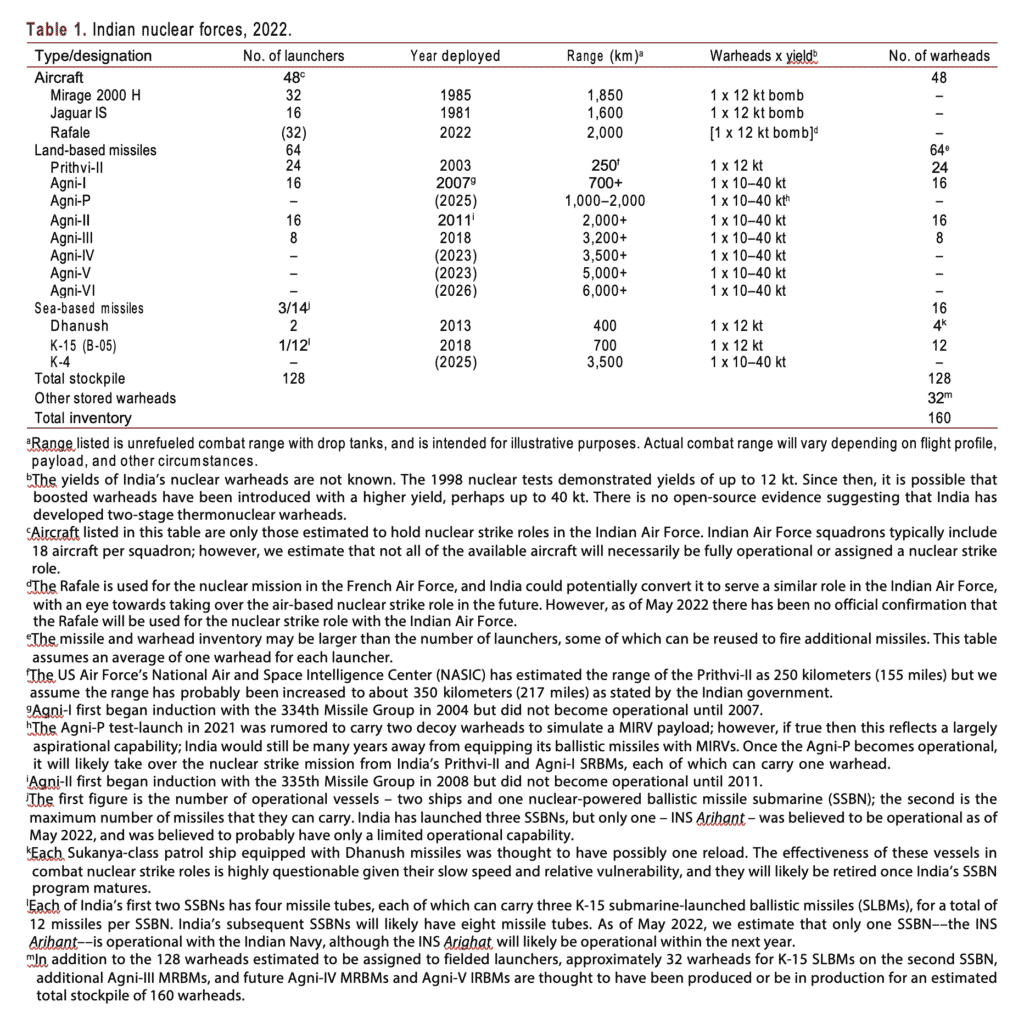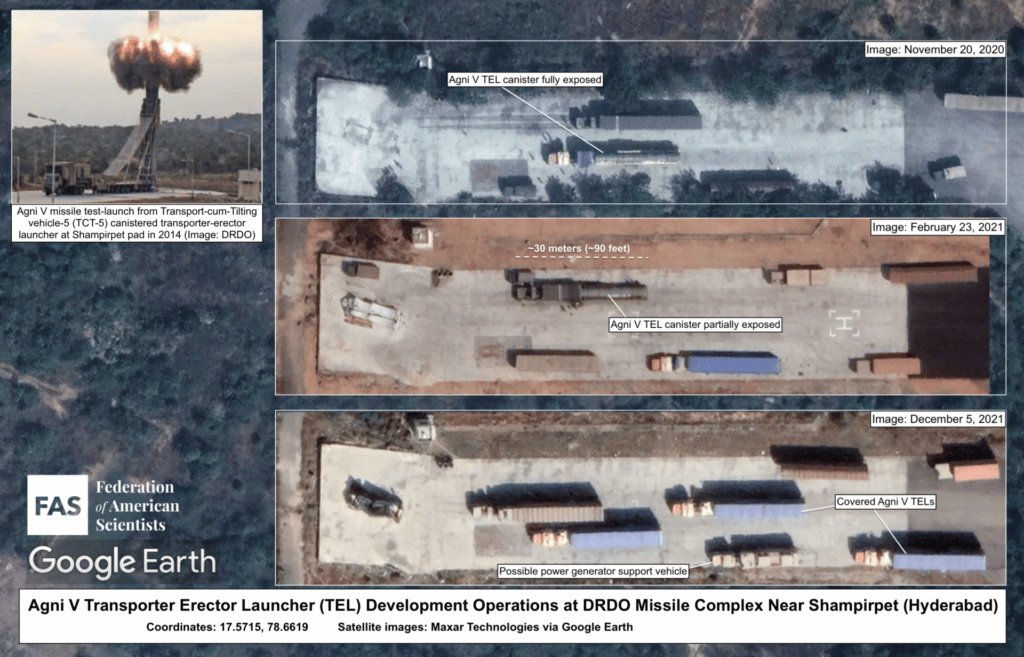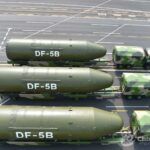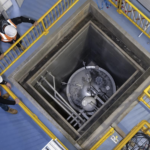Nuclear Notebook: How many nuclear weapons does India have in 2022?
By Hans M. Kristensen, Matt Korda | July 11, 2022
Nuclear Notebook: How many nuclear weapons does India have in 2022?
By Hans M. Kristensen, Matt Korda | July 11, 2022
Editor’s note: The Nuclear Notebook is researched and written by Hans M. Kristensen, director of the Nuclear Information Project with the Federation of American Scientists, and Matt Korda, a senior research associate with the project. The Nuclear Notebook column has been published in the Bulletin of the Atomic Scientists since 1987. This issue examines the status of India’s nuclear arsenal, which includes approximately 160 warheads. India continues to modernize its nuclear arsenal, with at least four new weapons systems now under development to complement or replace existing nuclear-capable aircraft, land-based delivery systems, and sea-based systems. Several of these systems are nearing completion and will soon be combat-ready. India is estimated to have produced enough military plutonium for 140 to 210 nuclear warheads but has likely produced only 160. Nonetheless, additional plutonium will be required to produce warheads for missiles now under development, and India is reportedly building several new plutonium production facilities. India’s nuclear strategy, traditionally focused on Pakistan, now appears to place increased emphasis on China, and Beijing is now in range of Indian missiles.
This article is freely available in PDF format in the Bulletin of the Atomic Scientists’ digital magazine (published by Taylor & Francis) at this link. To cite this article, please use the following citation, adapted to the appropriate citation style: Hans M. Kristensen & Matt Korda (2022) Indian nuclear weapons, 2022, Bulletin of the Atomic Scientists, 78:4, 224-236, DOI: https://doi.org/10.1080/00963402.2022.2087385
To see all previous Nuclear Notebook columns, click here.
Collecting and analyzing accurate information about India’s nuclear forces is a more challenging effort than for many other nuclear-armed states. India has never disclosed the size of its nuclear stockpile, and Indian officials do not regularly comment on the capabilities of the country’s nuclear arsenal. Although some official information can be derived from parliamentary inquiries, budget documents, government statements, and other sources, India generally maintains a culture of relative opacity regarding its nuclear arsenal. India has previously refused to divulge the costs of certain nuclear weapon programs, and in 2016, the Indian government added Strategic Forces Command – the agency responsible for operating the country’s nuclear arsenal – to a list of security organizations exempt from the India’s Right to Information Act, thus inhibiting journalists, researchers, and the public from getting access to critical information about India’s nuclear arsenal (Sarkar 2021; Government of India 2016).
In the absence of official information from the Indian government and military, local news and media outlets tend to embellish details about the country’s nuclear arsenal; for example, some outlets regularly claim that certain weapon systems are “nuclear-capable,” despite a lack of any official evidence to that effect. To that end, we generally rely on official sources and images – as well as commercially or freely-available satellite imagery – to analyze India’s nuclear arsenal and, whenever possible, try to corroborate the credibility of any unofficial claims with multiple sources. In particular, the research of open-source analysts such as @tinfoil_globe have proven to be highly valuable in analyzing Indian military bases using satellite imagery.
India continues to modernize its nuclear weapons arsenal and operationalize its nascent triad. We estimate that India currently operates eight different nuclear-capable systems: two aircraft, four land-based ballistic missiles, and two sea-based ballistic missiles. At least four more systems are in development, most of which are thought to be nearing completion and to be combat-ready soon. Beijing is now in range of Indian ballistic missiles.
India is estimated to have produced approximately 700 kilograms (plus or minus about 150 kilograms) of weapon-grade plutonium, sufficient for 138 to 213 nuclear warheads (International Panel on Fissile Materials 2022); however, not all the material has been converted into nuclear warheads. Based on available information about its nuclear-capable delivery force structure and strategy, we estimate that India has produced 160 nuclear warheads (see Table 1). It will need more warheads to arm the new missiles that it is currently developing.

India’s source of weapon-grade plutonium has been the operational Dhruva plutonium production reactor at the Bhabha Atomic Research Centre complex near Mumbai, and until 2010 the CIRUS reactor at the same location. India has plans to significantly expand its plutonium production capacity by building at least one more plutonium production reactor. Moreover, the unsafe-guarded 500-megawatt Prototype Fast Breeder Reactor (PFBR) under construction at the Indira Gandhi Centre for Atomic Research near Kalpakkam could potentially increase India’s plutonium production capacity even further. The PFBR was originally scheduled to reach criticality in 2010; however, it has been marked by significant delays and is now expected to go critical by October 2022 (Government of India 2021a). The director of the research center has additionally stated that six more fast breeder reactors will come online within the next 15 years (Kumar 2018). Construction of the first two, to be located on-site at the center, will reportedly begin in October 2022 and are scheduled to become operational by the early 2030s (World Nuclear News 2022).
Nuclear doctrine
Tensions between India and Pakistan constitute one of the most concerning nuclear hotspots on the planet. These two nuclear-armed countries engaged in open hostilities as recently as November 2020, when Indian and Pakistani soldiers exchanged artillery and gunfire over the Line of Control, resulting in at least 22 deaths. The clash followed another incident in February 2019, when Indian fighters dropped bombs near the Pakistani town of Balakot in response to a suicide bombing conducted by a Pakistan-based militant group. In retaliation, Pakistani aircraft shot down and captured an Indian pilot before returning him a week later. The skirmish escalated into the nuclear realm when it triggered a convening of Pakistan’s National Command Authority, the body that oversees Pakistan’s nuclear arsenal. Speaking to the media at the time, a senior Pakistani official noted, “I hope you know what the [National Command Authority] means and what it constitutes. I said that we will surprise you. Wait for that surprise. You have chosen a path of war without knowing the consequence for the peace and security of the region” (Abbasi 2019).
In this context, the risk of conflict escalation between India and Pakistan remains dangerously high. In March 2022, India accidentally launched what appeared to be a BrahMos ground-launched cruise missile 124 kilometers (77 miles) into Pakistani territory, damaging civilian property. Pakistani officials subsequently claimed that India did not alert them using the high- level military hotline, and India did not even issue a public statement about the accident until two days later (Dawn 2022). Although the BrahMos is a conventional weapon, the unprecedented incident – as well as India’s deficient response – has serious implications for crisis stability between the two countries. In the absence of any de-escalation measures from India, Pakistan reportedly suspended all military and civilian aircraft for nearly six hours and placed frontline bases and strike aircraft on high alert (Bhatt 2022). If this same accidental launch had taken place during a period of heightened tensions, it is possible that the incident could have escalated into a very dangerous phase (Korda 2022).
While India’s primary deterrence relationship is with Pakistan, its nuclear modernization indicates that it is putting increased emphasis on its future strategic relationship with China. In November 2021, India’s then-Chief of Defence Staff stated in a press conference that China had become India’s biggest security threat (Sen 2021). Additionally, nearly all of India’s new Agni missiles have ranges that suggest China is their primary target. This posture is likely to have been reinforced after the 2017 Doklam standoff during which Chinese and Indian troops were placed on high alert over a dispute near the Bhutanese border. Tensions have remained high in subsequent years, particularly following another border skirmish in June 2020 that resulted in the deaths of both Chinese and Indian soldiers.
Further casualties have been reported due to Chinese-Indian military skirmishes as recently as January 2021 (BBC 2021).
The expansion of India’s nuclear forces against a militarily superior China (in terms of both conventional and nuclear forces) will result in significant new cap- abilities being deployed over the next decade. This development could potentially also influence how India views the role of its nuclear weapons against Pakistan. According to one analyst, “we may be witnessing what I call a ‘decoupling’ of Indian nuclear strategy between China and Pakistan. The force requirements India needs in order to credibly threaten assured retaliation against China may allow it to pursue more aggressive strategies – such as escalation dominance or a ‘splendid first strike’ – against Pakistan” (Narang 2017).
India has long adhered to a nuclear no-first-use policy. This policy, however, was weakened by India’s 2003 declaration that it could potentially use nuclear weapons in response to chemical or biological attacks – which would therefore constitute nuclear first use, even if it were in retaliation. Moreover, amid the 2016 border skirmishes with Pakistan, India’s then-defense minister Manohar Parrikar indicated that India should not “bind” itself to the no-first-use policy (Som 2016). Although the Indian government later explained that the minister’s remarks represented his personal opinion, the debate highlighted the conditions under which India would consider using nuclear weapons. Current defense minister Rajnath Singh has also publicly questioned India’s future commitment to its no-first-use policy, tweeting in August 2019 that “India has strictly adhered to this doctrine. What happens in the future depends on the circumstances” (Singh 2019). Recent scholarship has further called India’s commitment to its no-first-use policy into question, with some analysts asserting that “India’s NFU [no-first-use] policy is neither a stable nor a reliable predictor of how the Indian military and political leadership might actually use nuclear weapons” (Sundaram and Ramana 2018). Despite questions about the future of India’s NFU policy, it might have served to limit somewhat the scope and strategy of Indian nuclear forces for the first two decades of its nuclear era.
Additionally, although India has long been thought to store its nuclear warheads separately from deployed launchers, some analysts have speculated that India may have increased the readiness of its arsenal over the past decade by “pre-mating” some warheads with missiles in canisters for a subsection of the ballistic missile launchers, and possibly also storing some bombs at air bases (Clary and Narang 2018, 36–37; Narang 2013). There is still uncertainty about the readiness of the arsenal on a day-to-day basis, since the only two canistered missiles – Agni-V and Agni-P – are not yet operationally deployed. But this trend will likely strengthen with deployed of canistered launchers and India’s development of a sea-based leg of its nuclear triad, which, at least in the way the United States and Russia operate ballistic missile submarines, has typically involved mating warheads with missiles.
Aircraft
Fighter-bombers were India’s first and only nuclear strike force until 2003, when the Prithvi-II nuclear-capable ballistic missile was fielded. Despite considerable progress since then in building a diverse arsenal of land-and sea-based ballistic missiles, aircraft continue to serve a prominent role as a flexible strike force in India’s nuclear posture. We estimate that three or four squadrons of Mirage 2000H and Jaguar IS aircraft at three bases are assigned nuclear strike missions against Pakistan and China.
The Mirage 2000H Vajr (“divine thunder”) fighter- bombers are deployed with the 1st, 7th, and possibly the 9th squadrons of the 40th Wing at Maharajpur (Gwalior) Air Force Station in northern Madhya Pradesh. We estimate that one or two of these squadrons has a secondary nuclear mission. Indian Mirage aircraft also occasionally operate from the Nal (Bikaner) Air Force Station in western Rajasthan, and other bases might potentially function as nuclear dispersal bases as well.
The Indian Mirage 2000H was originally supplied by France, which used its domestic version (Mirage 2000N) in a nuclear strike role for 30 years, until its retirement in the summer of 2018. The Indian Mirage 2000H is undergoing upgrades to extend its service life and enhance its capabilities to include new radar, avionics, and electronic warfare systems; the modernized version is called Mirage 2000I. Although the modernization program for 51 Mirage 2000I aircraft was scheduled to be completed by the end of 2021, the program is behind schedule, with only about half of the aircraft having been modernized by the expected deadline (Philip 2022). India also intends to purchase 24 Mirage 2000 aircraft that had been previously phased out of the French Air Force and will use the scavenged parts to maintain the Indian Air Force’s existing Mirage squadrons (The Print 2021).
The Indian Air Force also operates four squadrons of Jaguar IS/IB Shamsher (“sword of justice”) aircraft at three bases (a fifth squadron flies the naval IM version). These include the 5th and 14th squadrons of the 7th Wing at Ambala Air Force Station in northwestern Haryana, the 16th and 27th squadrons of the 17th Wing at Gorakhpur Air Force Station in northeastern Uttar Pradesh, and the 6th and 224th squadrons of the 33rd Wing at Jamnagar Air Force Station in southwestern Gujarat. We estimate that one or two of the squadrons at Ambala and Gorakhpur (one at each base) might be assigned a secondary nuclear strike mission. Jaguar aircraft also occasionally operate from the Nal (Bikaner) Air Force Station in western Rajasthan. The Jaguar, designed jointly by France and Britain, was nuclear-capable when deployed by those countries.
The Jaguar is getting old and might be retired from the nuclear mission soon – if this hasn’t happened already. Half of the Jaguars have received the so-called DARIN-III precision-attack and avionics upgrade since 2017 (Ministry of Defence 2017), but the upgrade of the second half of the inventory was scrapped in August 2019 due to its prohibitive cost and long timeline. Instead, the air force will reportedly phase out its Jaguar fleet over the next 15 years. In October 2019, India’s Air Chief Marshal declared that the Indian Air Force’s six Jaguar squadrons of approximately 108 fighters would begin retiring in early 2020 (Shukla 2019); however, this may have been pushed back to 2024 in order to bring India closer to its goal of maintaining enough squadrons to simultaneously deter both Pakistan and China over the coming decade (Shukla 2021a).
On September 23, 2016, India and France signed an agreement for delivery of 36 Rafale aircraft (Ministry of Defence 2017). The order was considerably reduced from initial plans to buy 126 Rafales. The Rafale is used for the nuclear mission in the French Air Force, and India could potentially convert it to serve a similar role in the Indian Air Force, with an eye towards taking over the air-based nuclear strike role in the future. The Indian defense minister formally received the first Rafale (tail number RB-001) at a special ceremony in France in October 2019, followed by two more a month later. After initial delays due to the Covid-19 pandemic outbreak and subsequent lockdowns in both France and India, the full shipment of the 36 aircraft was completed on-schedule by April 2022 (Hindustan Times 2022). All 36 Rafales are outfitted with 13 “India-Specific Enhancements,” which include new radars, cold-weather engine start-up devices, 10-hour flight data recorders, helmet-mounted display sights, and electronic warfare and friend-or-foe identification systems (Dominguez 2019).
The Rafales are being deployed in two equally-sized squadrons of 18 fighters and four dual-seat trainers: one squadron (17th “Golden Arrows” Squadron) at Ambala Air Base Station, located only 220 kilometers (137 miles) from the Pakistani border, and the other squadron (101st “Falcons of Chamb and Akhnoor” Squadron) at Hasimara Air Force Station in West Bengal. New infrastructure developments to accommodate the planes are being constructed at both bases, and the Indian Air Force has reinstated the squadrons to active duty after they had both been decommissioned years earlier (Indian Air Force 2021).
Land-based ballistic missiles
India has four types of land-based, nuclear-capable bal- listic missiles that appear to be operational: the short-range Prithvi-II and Agni-I, the medium-range Agni-II, and the intermediate-range Agni-III. At least three other Agni missiles are in development and nearing deployment: the medium-range Agni-P, the intermediate-range Agni-IV, and the near-intercontinental-range Agni-V.
It remains to be seen how many of these missile types India plans to keep in its arsenal. Some may serve as technology development programs toward longer-range missiles. Although the Indian government has made no statements about the future size or composition of its land-based missile force, short-range and redundant missile types could potentially be discontinued, with only medium-and long-range missiles deployed in the future to provide a mix of strike options against Pakistan and China. Otherwise, the government seemingly appears to be planning to field a diverse missile force that will be expensive to maintain and operate.
The Prithvi-II missile was “the first missile to be developed” under India’s Integrated Guided Missile Development Program for “India’s nuclear deterrence,” according to the government (Press Information Bureau 2013). The missile can deliver a nuclear or conventional warhead to a range of 350 kilometers (217 miles). Given the relatively small size of the Prithvi missile (nine meters long and one meter in diameter), the launcher is difficult to spot in satellite images and therefore little is known about its deployment locations. It is thought India has four Prithvi missile groups (222, 333, 444, and 555) with about 30 launchers deployed close to the border with Pakistan. Possible locations include Jalandhar in Punjab, as well as Banar, Bikaner, and Jodhpur in Rajasthan.
The two-stage, solid-fuel, road-mobile Agni-I missile became operational in 2007, three years after its induction into the armed forces. The short-range missile can deliver a nuclear or conventional warhead to a distance of approximately 700 kilometers (435 miles). The mission of Agni-I is thought to be focused on targeting Pakistan; we estimate that up to 20 launchers are deployed in western India, possibly including the 334th Missile Group. In September 2020, India used an Agni-I booster to conduct a test of its developmental scramjet-powered Hypersonic Technology Demonstrator Vehicle (Jha 2020).
The two-stage, solid-fuel, rail-mobile Agni-II – an improvement on the Agni-I – can deliver a nuclear or conventional warhead to a distance of more than 2,000 kilometers (1,243 miles). The missile may have been inducted into the armed forces in 2008, but technical issues delayed its operational capability until 2011. Around 10 launchers are thought to be deployed in northern India, possibly including the 335th Missile Group. Targeting is probably focused on western, central, and southern China. Although the Agni-II appeared to suffer from technical issues and failed several of its previous test launches, more recent successful tests in 2018 and 2019 indicate that previous technical issues could have since been resolved (Liu 2018; The Hindu 2019).
The Agni-III – a two-stage, solid-fuel, rail-mobile, intermediate-range ballistic missile – can deliver a nuclear warhead to a distance of over 3,200 kilometers (1,988 miles). The Indian Ministry of Defence declared in 2014 that the Agni-III is “in the arsenal of the armed forces” (Ministry of Defence 2014) and the Strategic Forces Command conducted its fifth user trial on November 30, 2019, from Abdul Kalam Island on India’s east coast. The Agni-III failed its first night trial – deemed a “very crucial” test – with the missile falling into the sea after the first-stage separation (Rout 2019). No test launches of the Agni-III have been publicly reported since this failed test in 2019.
It is still early in the Agni-III deployment; there are probably fewer than 10 launchers deployed, and the full operational status is uncertain. The longer range potentially allows India to deploy the Agni-III units further back from the Pakistani and Chinese borders. More than a decade ago, while the missile was still under development, an army spokesperson remarked, “With this missile, India can even strike Shanghai” (India Today 2008) – although this would require launching the Agni-III from the very northeastern corner of India. From that region, the Agni-III would, for the first time, bring Beijing within range of Indian nuclear weapons.
India is also developing the Agni-IV missile – a two-stage, solid-fuel, road- and rail- mobile intermediate-range ballistic missile with the capability to deliver a single nuclear warhead to a distance of over 3,500 kilometers (2,175 miles), with the Ministry of Defence listing the range as 4,000 kilometers (2,485 miles) (Ministry of Defence 2014). Following the final development test in 2014, the ministry declared that Agni-IV “serial production will begin shortly.” Since then, three user launches have been conducted by the Strategic Forces Command, the most recent in December 2018, but the missile is not yet fully operational.
Although the Agni-IV will be capable of striking targets in nearly all of China from northeastern India (including Beijing and Shanghai), India is also developing the longer-range Agni-V – a three-stage, solid-fuel, road-mobile, near-intercontinental ballistic missile (ICBM) capable of delivering a warhead to a distance of more than 5,000 kilometers (3,100 miles). The extra range will allow the Indian military to establish Agni-V bases in central and southern India, further away from the Chinese border. The Agni-V has been successfully flight tested eight times in total, with the most recent test launch conducted in October 2021. The 2021 test was the first user trial for the Agni-V, and additional tests will likely be required before the missile becomes operational (Government of India 2021b; Philip 2021a).
The Agni-V missile brings an important new capability to the Indian strike force. Unlike current Indian land-based ballistic missiles, the Agni-V is carried in a sealed canister on the launcher. The first two test- launches used a rail launcher, but since 2015, all launches have been conducted from a road-mobile launcher. The launcher, which is known as the Transport-cum-Tilting vehicle-5 (TCT-5), is a 140-ton, 30-meter, 7-axle trailer pulled by a 3-axle Volvo truck (DRDO Newsletter 2014). The canister design “will reduce the reaction time drastically . . . just a few min- utes from ‘stop-to-launch,’” the former head of India’s Defence Research and Development Organisation said in 2013 (Times of India 2013). Several Agni-V trans- porter erector launchers (TELs) are clearly visible on commercial satellite imagery of the Defence Research and Development Organisation’s (DRDO) integration center north of Hyderabad, as well as at other sites across the country (see Figure 1).

In June and December 2021, India test-launched its new two-stage, solid-fuel, Agni-P medium-range ballistic missile, which the Indian Government calls a “new generation” nuclear-capable ballistic missile (Government of India 2021c). The Agni-P is India’s first shorter-range ballistic missile (SRBM) to incorporate more sophisticated rocket motors, propellants, avionics packages, and navigation systems found in India’s newer, longer-range missiles like the Agni-IV and Agni-V. Importantly, the Agni-P is also carried in a sealed canister, similarly to the Agni-V (Korda and Kristensen 2021). One senior DRDO official remarked during the early stages of the Agni-P’s development that, “As our ballistic missiles grew in range, our technology grew in sophistication. Now the early, short-range missiles, which incorporate older technol- ogies, will be replaced by missiles with more advanced technologies. Call it backward integration of technology” (Shukla 2016). Statements like these, coupled with the Agni-P’s clear capability upgrade over the early Agni-I and Agni-II missiles – which utilize older and less robust propellants, airframes, and hydraulic actuators, as well as less accurate guidance systems – suggest that the Agni-P will eventually replace these older missiles once it becomes operational (Shukla 2021b).
India is also developing a conventional SRBM known as the Pralay. The Pralay was most recently tested in December 2021 and is reportedly intended to take over the conventional role currently occupied by the dual-capable Prithvi-II and Agni-I SRBMs (Government of India 2021d; Unnithan 2021). The splitting of these nuclear and conventional short-range missions between the new Agni-P and Pralay missiles, respectively, could help reduce the risk of misunderstanding (conventional-nuclear entanglement) during a conflict. This could be further bolstered by the fact that the new Agni-P will likely be operated by Strategic Forces Command – which is responsible for India’s nuclear arsenal – while the Pralay will be operated by the Indian Army’s artillery corps (Philip 2021b).
The June 2021 test of India’s Agni-P missile was rumored to have carried two maneuverable decoys to simulate a payload equipped with multiple independently targetable reentry vehicles (MIRVs); however, this was not confirmed by the Indian Ministry of Defence (Pandit 2021). Similarly, press reports surrounding the Agni-V user trial in October 2021 claimed that the missile could be equipped with MIRVs (Rout 2021). However, there is good reason to doubt that India can or will add MIRVs to its missiles soon. There are no official reports that the Indian government has approved a MIRV development program, and loading multiple warheads on the Agni-V would reduce its extra range – a key purpose of developing the missile in the first place.
The Agni-V is estimated to be capable of delivering a payload of 1.5 tons (the same as the Agni-III and Agni-IV), and India’s first- and second- generation warheads, even modified versions, are thought to be relatively heavy compared with warheads developed by other nuclear-armed states that deploy MIRVs. However, it took the Soviet Union and the United States hundreds of nuclear tests and 25 years of continued effort to develop re-entry vehicles small enough to equip a ballistic missile with MIRVs. Moreover, deploying missiles with multiple warheads would invite questions about the credibility of India’s minimum deterrent doctrine; using MIRVs would reflect a strategy to quickly strike multiple targets and would also run the risk of triggering a warhead race with adversaries. Unless China develops an efficient missile defense system with capability against intermediate-range ballistic missiles, there seems to be no military need for MIRVs on Indian missiles (Kristensen 2013).
It seems likely, though, that China’s recent decision to equip some of its ICBMs with MIRVs, and Pakistan’s announcement in January 2017 that it had test-launched a new Ababeel medium-range ballistic missile with MIRVs, could strengthen the hand of those in the Indian military-industrial complex who favor development of a MIRV capability, if for no other reason than to avoid falling behind in MIRV technology development.
Although Ministry of Defence officials a few years ago indicated that India’s strategic missile force will be “capped for the present with the Agni-V, with no successor or next series on the horizon or even on the drawing board” (Gupta 2018), India apparently has also begun development of a true ICBM, known as Agni-VI. Official data is scarce, but an article posted on the government’s Press Information Bureau website in December 2016 claimed the Agni “will have a strike- range of 8,000–10,000 kilometers” (4,970 to 6,210 miles) and will “be capable of being launched from submarines as well as from land” (Ghosh 2016). Whether these claims are accurate remains to be seen for a range improvement of roughly 50 percent to nearly 100 percent of that of the Agni-V seems exaggerated. The US Air Force’s National Air and Space Intelligence Center estimates the range to be closer to 6,000 kilometers (3,730 miles) (National Air and Space Intelligence Center 2020).
India has also converted some of its ballistic missile technology into an anti-satellite interceptor. In March 2019, the Defence Research and Development Organisation completed its first successful anti-satellite test “Mission Shakti” against one of its own satellites. According to the Indian Ministry of Defence, the interceptor was a three-stage missile with two solid rocket boosters, derived from its indigenous ballistic missile defense program (Ministry of Defence 2019, 96). The destruction of the satellite created a large debris field of hundreds of pieces, and while most reentered the Earth’s atmosphere, dozens were kicked into higher orbit by the impact (Grush 2019). Unidentified Indian military sources have also speculated that the interceptor likely utilizes the same propulsion system as that of the Agni-V ballistic missile, which is still in development (Bedi 2019).
Sea-based ballistic missiles
India operates a ship-launched and a submarine-launched, nuclear-capable ballistic missile and is developing a second submarine-launched ballistic missile for eventual deployment on a small evolving fleet of nuclear-powered ballistic missile submarines.
The ship-based ballistic missile is the Dhanush, a 400-kilometer (249-mile) single-stage, liquid-fuel, short-range ballistic missile designed to launch from the back of two specially configured Sukanya-class patrol vessels (Subhadra and Suvarna); each ship can carry two missiles. The Dhanush is a ship-based variant of the Prithvi-II. The Dhanush has not been test launched since February 2018 and its utility as a strategic deterrence weapon is severely limited by its relatively short range; the ships carrying it would have to sail dangerously close to the Pakistani or Chinese coasts to target facilities in those countries, making them vulnerable to counterattack. The two Sukanya-class ships are homeported at the Karwar naval base on the Indian west coast. We suspect the Dhanush will be retired (if it hasn’t happened already) once one or two of the Arihant-class nuclear submarines become fully operational.
India’s first indigenous nuclear-powered ballistic missile submarine (SSBN), the INS Arihant, was commissioned in August 2016, but spent most of 2017 and the first half of 2018 undergoing repairs after its propulsion system was crippled by water damage (Peri and Joseph 2018). In November 2018, Indian Prime Minister Narendra Modi announced that the Arihant had completed its first deterrence patrol, officially marking the completion of India’s nuclear triad. He additionally stated that the deployment constituted “a fitting response to those who indulge in nuclear blackmail” (Singh 2018). The “deterrence patrol” lasted approximately 20 days; however, it is unclear whether the boat was actually equipped with nuclear weapons. The Arihant appears to bear a strong resemblance to the Russian-built Kilo-class attack submarines that are operated by the Indian Navy, with the exception of a unique missile compartment designed to accommodate India’s submarine-launched ballistic missiles (Sutton 2021).
Although the INS Arihant conducted two submerged unit trials of nuclear-capable K-15 missiles in August 2018, sources indicate that it will primarily serve as a training vessel and technology demonstrator and that it will not be deployed for nuclear deterrence patrols as additional SSBNs come online (Gady 2018). These claims are further bolstered by the fact that the Arihant has rarely been seen, photographed, or written about in recent years, despite it being a significant technological achievement for India’s Navy (Sutton 2021).
A second SSBN, the INS Arighat (previously intended to be named Aridhaman), was launched on November 19, 2017, and was expected to be commissioned into the Indian Navy in 2020 (Pubby 2020); however, the Arighat only began sea trials at the beginning of 2022, and as of May 2022 there had been no announcement to confirm the boat’s commissioning, indicating that it has likely been delayed (Bhattacharjee 2022). The Arighat will be followed by two more SSBNs, temporarily designated S4 and S4 (Bedi 2017), which are scheduled to enter service before 2024 (Pubby 2020); however, it is likely that these boats will be delayed as well. The first of these, the S4, was launched in November 2021, and is noticeably longer and wider than India’s first two SSBNs (Biggers 2021). Satellite images indicate the S4 is approximately 18 meters longer than the first two SSBNs and equipped with eight missile tubes, twice the number on the Arihant and Arighat.
India also appears to be developing its next generation of SSBNs – the S-5 class. A series of tweets by the Indian vice president during his visit to the country’s Naval Science & Technology Laboratory revealed some details about what this new class of submarines might look like (Vice President of India 2019). Photos indicate that the new submarines will be significantly larger than the current Arihant-class and could have eight or more launch tubes. Analysts speculate that this new class of submarines could enter service in the late 2020s, after the completion of all four Arihant-class boats (Sutton 2019). A naval base for the SSBNs named INS Varsha is currently under construction near Rambilli on the Indian east coast, and will reportedly be located near a facility associated with the Bhabha Atomic Research Centre – India’s primary nuclear research institution, which is also tied to its nuclear weapons program. The INS Varsha base is undergoing extensive construction with numerous tunnels into a mountain, large piers, and support facilities (see Figure 2).

To arm the SSBNs, India has developed one nuclear-capable sea-launched ballistic missile, and is working on another: the current K-15 (also known as Sagarika or B-05) submarine-launched ballistic missile (SLBM) with a range of 700 kilometers (435 miles), and the future K-4 SLBM with a range of about 3,500 kilometers (2,175 miles). The relatively short range of the K-15 would not allow the SSBNs to target Islamabad, only southern Pakistan, and the submarines would not be able to target China at all unless they sail through the Singapore Strait, deep into the South China Sea. Therefore, despite its induction in the summer of 2018, the K-15 should be seen primarily as an intermediate program intended to develop the technology for future more capable missiles.
The K-4, which reportedly has similar characteristics to the Agni-III intermediate-range ballistic missile, has undergone six test launches – two of which took place only five days apart in January 2020 – and is reportedly “virtually ready” for serial production (Pandit 2020). Launch videos of the K-4 SLBM indicate that rather than the cold launch system typically used by most SLBMs – through which the missile gets ejected from the launch tube via a gas generator – the K-4 uses two small motors on the front end of the missile to pull it several meters above the surface of the water before the main engine ignites (DRDO 2015).
Rumors about the K-4 claim that it is highly accurate, reaching “near zero circular error probability,” according to the Defence Research and Development Organisation (Panda 2016), and one official reportedly claimed: “Our Circular Error Probability is much more sophisticated than Chinese missiles” (Peri 2020). Such claims, however, should probably be taken with a grain of salt. With a range of 3,500 kilometers (2,175 miles), the K-4 will be able to target all of Pakistan and most of China from the northern Bay of Bengal. Each SSBN launch tube will be capable of carrying one K-4 or three K-15s. As is usual with nuclear programs, there are rumors and speculation that each K-4 SLBM will be capable of carrying more than one warhead, but that seems highly unlikely.
In addition, senior Indian defense officials have stated that the Defence Research and Development Organisation is reportedly planning to develop a 5,000-kilometer (3,107-mile) range SLBM that matches the design of the land-based Agni-V and would allow Indian submarines to target all of Asia, parts of Africa, Europe, and the Indo-Pacific region, including the South China Sea. The missile will carry the same K- series label as the two other SLBMs currently in development and was initially expected to be tested sometime in 2022 (Gupta 2020), although as of May 2022 no such launch had taken place.
Cruise missiles
India is developing a ground-launched cruise missile – the Nirbhay. The missile looks similar to the American Tomahawk or the Pakistani Babur and might also be intended for air- and sea- based deployment. The Indian Ministry of Defence describes the Nirbhay as “India’s first indigenously designed and developed long-range subsonic cruise missile having 1,000-kilo- meter (621-mile) range and capable of carrying up to 300-kilogram warheads” (Ministry of Defence 2019, 100). After a series of failed tests dating back to 2013, successful flight tests in November 2017 and April 2019 indicate that some of the technical challenges have been resolved.
Although there are many rumors that the Nirbhay is dual-capable, neither the Indian government nor the US intelligence community has publicly stated such (Pandit 2017). A test of the Nirbhay cruise missile fitted with an indigenous propulsion system was scheduled for April 2020; however, the test was postponed until August 2021, and resulted in a partial success, as the engine fired correctly but the delivery platform subsequently crashed (Gupta 2021). The Defence Research and Development Organisation confirmed in early 2020 that additional variants of the Nirbhay cruise missile – including submarine-launched and air-launched versions – are in the early stages of planning and development (Udoshi 2020)
Disclosure statement
No potential conflict of interest was reported by the authors.
Funding
This research was carried out with grants from the John D. and Catherine T. MacArthur Foundation, the New-Land Foundation, the Ploughshares Fund, and the Prospect Hill Foundation.
Together, we make the world safer.
The Bulletin elevates expert voices above the noise. But as an independent nonprofit organization, our operations depend on the support of readers like you. Help us continue to deliver quality journalism that holds leaders accountable. Your support of our work at any level is important. In return, we promise our coverage will be understandable, influential, vigilant, solution-oriented, and fair-minded. Together we can make a difference.






















